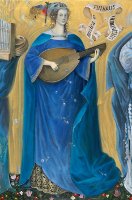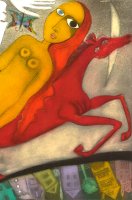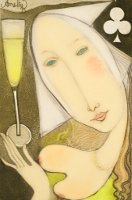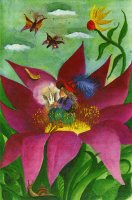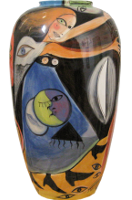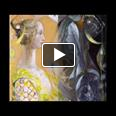About the
Altar
The Altar of the Resurrected Sun is product of nearly a decade’s work combining the beauty of music, poetry and art, reflections on the works of the Old European Masters from the middle-ages to the Rococo, and an all-embracing philosophical world-view in one complete, aesthetic whole.
Realized as a digital media project inspired by Renaissance and Baroque altars, my Altar of the Resurrected Sun can be seen as a symbolic representation of the journey of the human soul, reflected in a special organization of my paintings. The project is implemented in two parts: a static version, itself consisting of the two versions seen on this web page; and a “moving” version – a movie clip based on the (static) computer images. The altar’s name itself comes from the central work from 2009, also called Altar of the Resurrected Sun, which expresses in a new and unique way the subject of resurrection — of Christ and of the human soul.
Spatially, the altar is subdivided into three concentric rings, each with a meaning of its own. The outer ring contains the 12 signs of the Zodiac, beginning with Aries towards the right and proceeding anti-clockwise, in accordance with the Sun’s movement across the sky, finishing at Piesces on the bottom right. This movement also represents the human spirit passing through the Zodiacal signs, birth and re-birth, death and life, and the journey of man through the cosmos.
The inner ring, on the other hand, contains the 7 planets: the Moon, Mercury, Venus, Mars, the Sun, Jupiter and Saturn (in no particular order), which are always connected to the planetary spheres in the writings of the medieval philosophers. To these can be added the 8th sphere, which in my work is a dyptich (Octava Spera I and Octava Spera II), as well as what in Dante’s "Divine Comedy" is called the Empyrian: my dyptich White Angels. All the Angels in the top part of the ring are Heavenly musicians, singing and glorifying the Name of God, with the top three representing the Divine love, wisdom and truth — one could say, the highest sphere. According to Dante, man passes through these celestial spheres on his or her heaven-ward journey, but there are many more dimensions of interpretation.
The centre of the altar collects a number of my works concerned with the life of Christ, such as the Annunciation dyptich and the Deposition from the Cross, as well as the Journey of a Star representing His saints and martyrs. The subject of resurrection, at the very centre of the altar, expresses a great mystery, both human and Divine.
Besides its more "cosmic", universally human dimensions, the altar reflects my own personal journey through life as well, collecting as it does some of my most major individual works and cycles, including the Zodiac Series from 2006 and the Angels of the Testament Series from 2009, 2010 and 2011.
The computer realization of the altar images was made in collaboration with digital designer David Hobbs.
In the (static) version of the image using an inner "virtual" light, the light source is the Sun itself at the centre, with everything else illuminated in relative fashion. The paintings themselves are not seen exactly as they are in their natural settings, but as representations, experienced within the environment created by the central, internal light.
In the version of the image using an external "natural" light, the light source is a reflected light from outside the altar image, illuminating everything in strict accordance with the laws of physics. The paintings themselves are seen exactly as they are in their natural surroundings.
About the
Music
Music is an inseparable part of my art. Each painting in the altar is infused with the musical works of a particular composer and their ideas in an individual synthesis. My altar as a whole, however, is not related to music in the same way. Nevertheless, I wanted very strongly to provide a musical, listening experience for people looking at the altar images, and have therefore chosen music that I believe aligns well the ideas of my altar most generally. My intention is that people meditate on the altar images while listening to the music (at the top of the page), interactively exploring the individual works and contemplating their numerous ideas in the created contexts, i.e. interpreting or lighting the works for themselves both externally and internally.
For the version of my altar with external light, I have chosen a performance of Petites Esquisses d’Oiseaux (Small sketches of birds) from 1985 by the French Postmodern composer Olivier Messiaen, played by Håkon Austbø, piano. These sketches of Messiaen are related to my altar inasmuch as they are strongly inspired by Nature and its beauty, its sounds, how the Sun’s light which touches the trees and flowers creates the outlines of countless forms and shapes. At the same time, the music is internally imbued with deep moral and religious values, with purity and crystalline tones expressing a striving towards perfection.
For the version of my altar with internal light, I have chosen a performance of the motet Confitebor tibi Domine (I confess to You Lord), ZWV71, by the Bohemian Baroque composer Jan Dismas Zelenka, sung by Tomás Král, bass, with the Visegrad Baroque Orchestra, conductor Marek Stryncl. This motet – a confession from the heart – is related to my altar inasmuch as, for me, it is my confession of the soul. The performance by Tomás Král is truly magnificent and very special – profound and noble – just like the music of Zelenka: both a dedication to the Divine beauty, which, together with my altar, I hope everyone will enjoy and appreciate.

 The Musical Connection in My Paintings
The Musical Connection in My Paintings
 On Fractality – cast in the form of a children’s story
On Fractality – cast in the form of a children’s story
 Poetry in English – a short collection
Poetry in English – a short collection
 Poetry in Bulgarian – a short collection
Poetry in Bulgarian – a short collection
